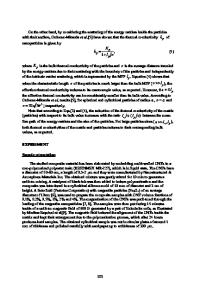Modeling of Carbon Nanotubes, Graphene and their Composites
This book contains ten chapters, authored by world experts in the field of simulation at nano-scale and aims to demonstrate the potentialities of computational techniques to model the mechanical behavior of nano-materials, such as carbon na
- PDF / 13,921,768 Bytes
- 341 Pages / 453.543 x 683.15 pts Page_size
- 76 Downloads / 428 Views
Konstantinos I. Tserpes Nuno Silvestre Editors
Modeling of Carbon Nanotubes, Graphene and their Composites
Springer Series in Materials Science Volume 188
Series Editors Zhiming M. Wang, Chengdu, People’s Republic of China Chennupati Jagadish, Canberra, ACT, Australia Robert Hull, Charlottesville, VA, USA Richard M. Osgood, New York, NY, USA Jürgen Parisi, Oldenburg, Germany
For further volumes: http://www.springer.com/series/856
The Springer Series in Materials Science covers the complete spectrum of materials physics, including fundamental principles, physical properties, materials theory and design. Recognizing the increasing importance of materials science in future device technologies, the book titles in this series reflect the state-of-the-art in understanding and controlling the structure and properties of all important classes of materials.
Konstantinos I. Tserpes Nuno Silvestre •
Editors
Modeling of Carbon Nanotubes, Graphene and their Composites
123
Editors Konstantinos I. Tserpes Department of Mechanical Engineering and Aeronautics University of Patras Patras Greece
ISSN 0933-033X ISBN 978-3-319-01200-1 DOI 10.1007/978-3-319-01201-8
Nuno Silvestre Department of Mechanical Engineering, IDMEC University of Lisbon Lisbon Portugal
ISSN 2196-2812 (electronic) ISBN 978-3-319-01201-8 (eBook)
Springer Cham Heidelberg New York Dordrecht London Library of Congress Control Number: 2013950371 Ó Springer International Publishing Switzerland 2014 This work is subject to copyright. All rights are reserved by the Publisher, whether the whole or part of the material is concerned, specifically the rights of translation, reprinting, reuse of illustrations, recitation, broadcasting, reproduction on microfilms or in any other physical way, and transmission or information storage and retrieval, electronic adaptation, computer software, or by similar or dissimilar methodology now known or hereafter developed. Exempted from this legal reservation are brief excerpts in connection with reviews or scholarly analysis or material supplied specifically for the purpose of being entered and executed on a computer system, for exclusive use by the purchaser of the work. Duplication of this publication or parts thereof is permitted only under the provisions of the Copyright Law of the Publisher’s location, in its current version, and permission for use must always be obtained from Springer. Permissions for use may be obtained through Rights Link at the Copyright Clearance Center. Violations are liable to prosecution under the respective Copyright Law. The use of general descriptive names, registered names, trademarks, service marks, etc. in this publication does not imply, even in the absence of a specific statement, that such names are exempt from the relevant protective laws and regulations and therefore free for general use. While the advice and information in this book are believed to be true and accurate at the date of publication, neither the authors nor the editors nor the publisher can accept any legal responsibi
Data Loading...











